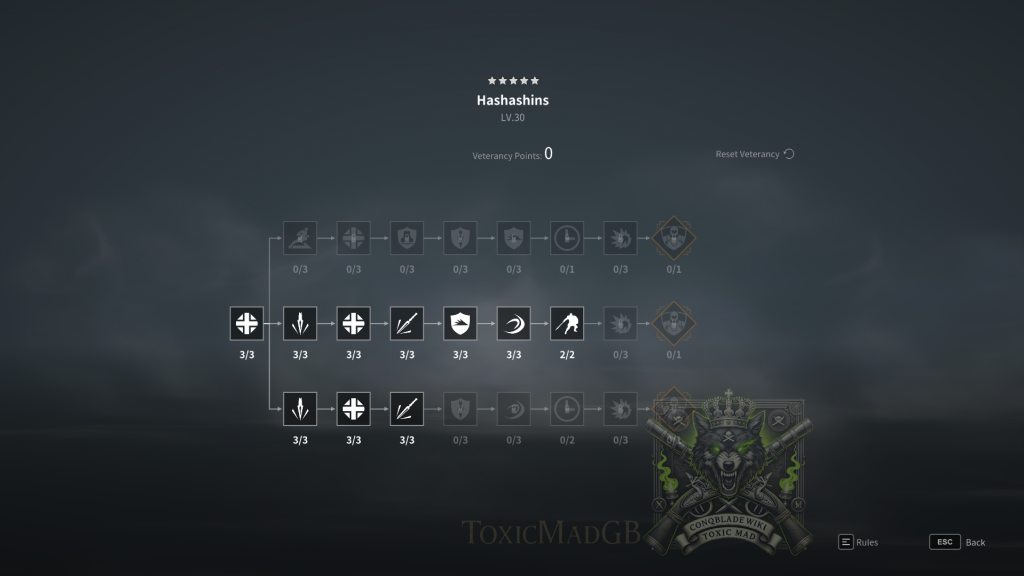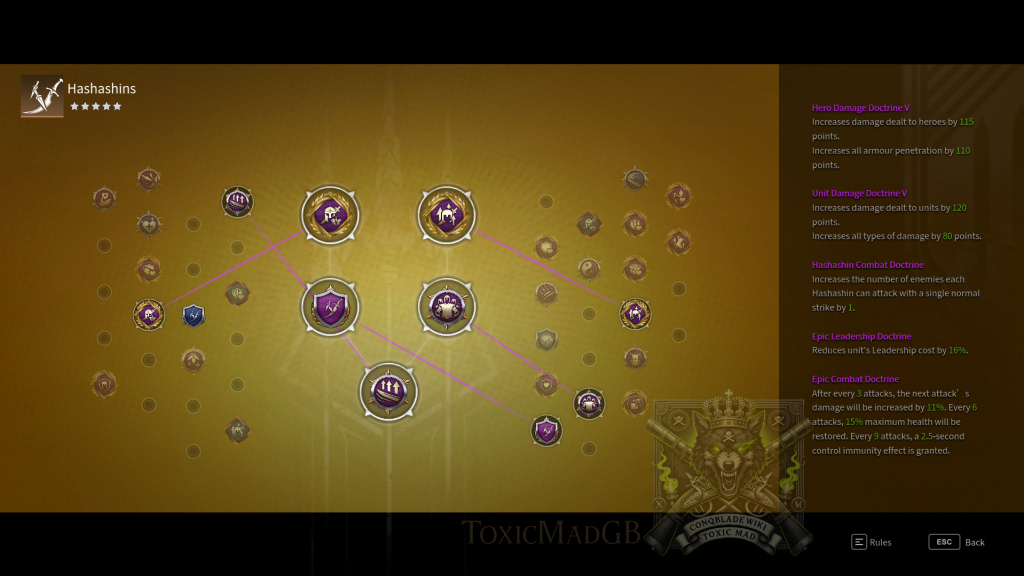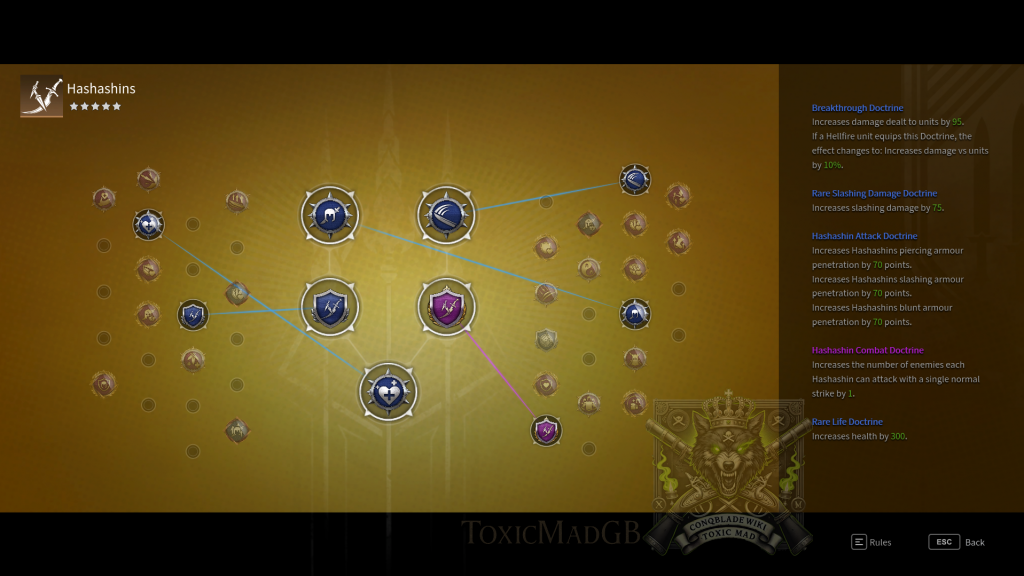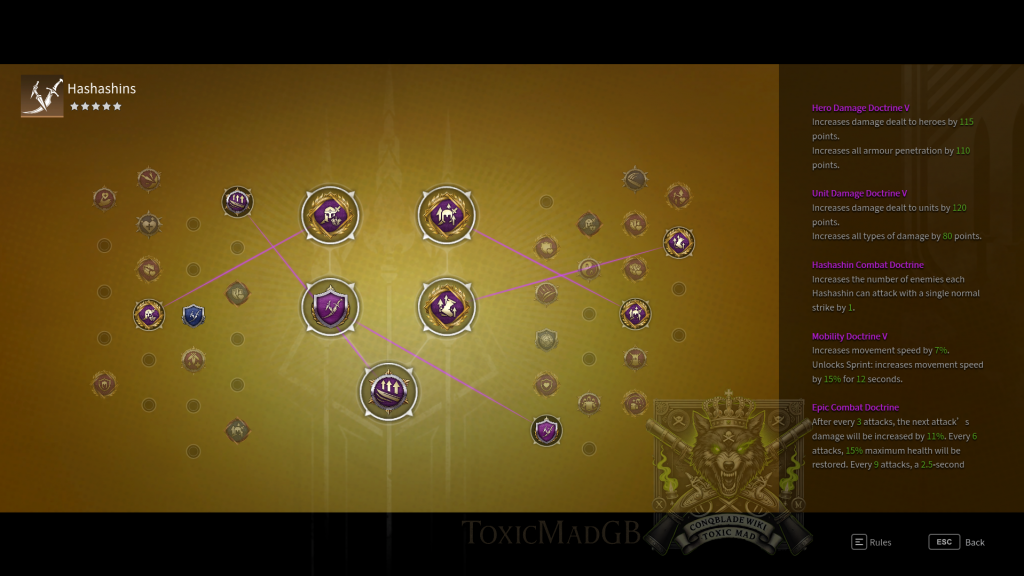Unit Guide: Hashashins
Hashashins
1 | Core Attributes
The Hashashins constitute a highly specialised golden infantry formation (★ ★ ★ ★ ★) whose combat value derives less from conventional line engagement and more from asymmetric force projection. The detachment comprises only 10 operatives; the low head‑count is offset by exceptional mobility, minimised signature and an Action‑Point (AP) resource that governs their combat actuators.
| Parameter | Specification | |‑|‑| | Unit size | 10 models | | Leadership | 295 L | | Primary armament | Dual daggers (short reach, slashing) | | Secondary resource | 2 AP (max); regeneration = 1 AP / 6 s | | Unlock method | Season XIII Scorpio (post‑Myrmidon challenge line) |
2 | Orders, AP Economy, Functional Logic
| Order | AP cost | Internal CD | Functional description | Operational implication | |‑|‑|‑|‑|‑| | Prowl | 2 | 0 s | Activates a semi‑stealth state. Upon contact the unit executes a leap‑slash that applies Bleed. | Primary initiating strike; requires full 2 AP reserve. | | Eviscerate | 2 | — | Three‑phase rotational combo; bonus damage scales with active Bleed. | Burst component for target liquidation. | | Smoke Bomb | 0 | 20 s | Deploys aerosol cloud: +30 % DR to Hashashins, –70 % ranged accuracy for enemies inside. | Shield for disengagement or micro‑zone denial. | | Shadow Walk (trait) | — | — | Projectile evasion while executing orders. | Enables diagonal approach vectors under ranged fire. | | Glass Daggers (penalty) | — | — | −20 % base armour; heightened vulnerability to blunt AoE. | Enforces a strictly cyclical engagement pattern. |
AP Paradigm: the unit’s efficacy hinges on executing Prowl + Eviscerate = 4 AP per engagement cycle. Expenditure mismanagement yields 6 s of tactical impotence.
3 | Strengths & Limitations
### 3.1 Strengths
- Alpha potential: highest initial DPS among non‑cavalry units of this tier.
- Compensatory survivability: Shadow Walk plus Smoke Bomb mitigate focus fire during the critical strike window.
- Minimal resupply burden: only 10 models, hence negligible kit drain.
### 3.2 Limitations
- Hero‑damage penalty (−50 %) curbs efficacy versus heavy commanders.
- Glass‑cannon profile: a single flamethrower tick can delete 30 % of the squad.
- AP dependency: mis‑used Prowl/Eviscerate strands the unit for six seconds.
4 | Doctrine Optimisation




5 | Micro‑Sequence
- Approach: Dispersed formation; vector outside enemy LoS.
- Initiate: Activate Prowl (2 AP) ~3 s before contact.
- Engage: Leap‑slash into rear‑line.
- Burst: Immediate Eviscerate (consumes remaining AP).
- Exfil: Deploy Smoke Bomb; slide back along friendly axis; await AP regeneration.
6 | Synergy & Counterplay
### 6.1 Complementary Units
- Tower‑shield formations to lock front line and cover withdrawal.
- Shock cavalry to generate flank pressure masking the Hashashin approach.
### 6.2 Primary Counters | Counter | Rationale | |‑|‑| | DoT projectiles | Continuous damage plus stealth reveal. | | Large‑radius CC (Flames, Fire, AOE ults | Override dodge frames, inflict mass casualties.
### Conclusion Hashashins fulfil a precision elimination role: neutralise high‑priority, low‑resilience targets within a 4‑AP burst envelope and disengage before retaliation. Commanders must internalise the Stealth → Burst → Smoke → Reset cycle to maximise operational longevity and consistently harvest the unit’s outsized damage potential.